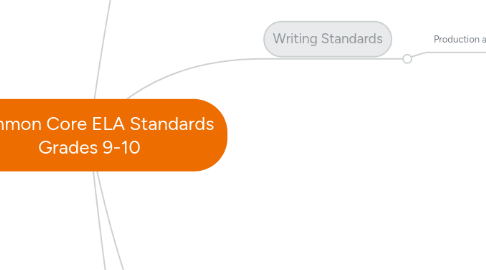
1. Reading Standards for Literature
1.1. Key Ideas and Details
1.1.1. 1. Site strong and thorough textual evidence to support analysis of what the text says explicitly as well as inferences drawn from the text
1.1.1.1. Using quotes from the text to support a claim.
1.1.1.2. Inference charts showing inference based on evidence
1.1.1.3. Using outside sources such as online databases to further support for claim.
1.1.2. 2. Determine a theme or central idea of a text and analyze in detail its development over the course of the text, including how it emerges and is shaped and refined by specific details; provide an objective summary of the text
1.1.2.1. Graphic organizer central theme with evidence from text
1.1.2.2. Writing an essay based on the theme of the text
1.1.2.3. Journal entries including evidence of theme within the text.
1.1.3. 3. Analyze how complex characters (e.g., those with multiple or conflicting motivations) develop over the course of a text, interact with other characters, and advance the plot of develop the theme.
1.1.3.1. Have students draw or create before and after "photos" of dynamic characters.
1.1.3.2. Create a timeline of major turning points for dynamic character
1.1.3.3. Have students write essay focusing on how the character's development effected the text as a whole.
2. Writing Standards
2.1. Production and Distribution of Writing
2.1.1. 4. Produce clear and coherent writing in which the development, organization, and style are appropriate to task, purpose, and audience.
2.1.1.1. Have students write various types of essays, including analytical, persuasive, and research.
2.1.1.2. Have students write creative pieces of writing, such as poetry, plays, etc.
2.1.1.3. Have students produce documents that will be relevant in the workforce, such as resumes, memos, professional emails, etc.
2.1.2. 5. Develop and strengthen writing as needed by planning, revising, editing, rewriting, or trying a new approach, focussing on addressing what is most significant for a specific purpose and audience.
2.1.2.1. Have students create outlines for their essays
2.1.2.2. Peer editing sessions in class
2.1.2.3. Have students perform editing and revision strategies such as CUPS and ARMS
2.1.3. 6. Use technology, including the internet, to produce, publish, and update individual or shared writing products, taking advantage of technology's capacity to link to other information and to display other information flexibly and dynamically.
2.1.3.1. Have the class collaborate on a wiki document.
2.1.3.2. Utilizing online discussion boards, like that on Blackboard.
2.1.3.3. Creating a webpage
3. Speaking and Listening Standards
3.1. Presentation of Knowledge and Ideas
3.1.1. 4. Present information, findings, and supporting evidence clearly, concisely, and logically (using appropriate eye contact, adequate volume, and clear pronunciation) such that listeners can follow the line of reasoning and organization, development, substance, and style are appropriate to purpose.
3.1.1.1. a. Plan and deliver an informative/explanatory presentation that: presents evidence in support of a thesis, conveys information from primary and secondary sources coherently, uses domain specific vocabulary, and provides a conclusion that summarizes the main points
3.1.1.1.1. In class debates on controversial topics
3.1.1.1.2. Oral presentations or impersonations on and of famous authors.
3.1.1.1.3. Powerpoint presentations based on previously written research paper.
3.1.1.2. b. Plan, memorize, and present a recitation (e.g., poem, selection from a speech or dramatic soliloquy) that: conveys the meaning of the selection and includes appropriate performance techniques (e.g., tone, rate, voice modulation) to achieve the desires aesthetic effect.
3.1.1.2.1. Dramatic performances of a scene from any play.
3.1.1.2.2. Performance of a piece of poetry.
3.1.1.2.3. Poetry Podcast Project (from video this week)
3.1.2. 5. Make strategic use of digital media (textual, graphical, audio, visual, interactive elements) in presentations to enhance understanding of findings, reasoning, and evidence to add interest.
3.1.2.1. Powerpoint presentations with visuals
3.1.2.2. Showing short video clips that are important and relevant to to the presentation.
3.1.2.3. Utilizing websites such as Prezi
3.1.3. 6. Adapt speech to a variety of contexts and tasks, demonstrating command of formal English when indicated or appropriate.
3.1.3.1. Performance of spoken word or free verse poetry.
3.1.3.2. Utilizing appropriate jargon relevant to topic
3.1.3.3. Verbally participating in classroom discussions, making valid and creative contributions to various topics.
4. Language Standards
4.1. Knowledge of Language
4.1.1. 3. Apply knowledge of language to understand how language functions in different contexts, to make effective choices for meaning or style, and to comprehend more fully when reading or listening.
4.1.1.1. a. Write and edit work so it conforms to the guidelines in style manual (MLA handbook, Turabian's Manual for Writers appropriate for the discipline and writing type.
4.1.1.1.1. Writing an essay in MLA format.
4.1.1.1.2. Compose an an annotated bibliography.
4.1.1.1.3. Choosing correct style of writing given the purpose and task at hand.
